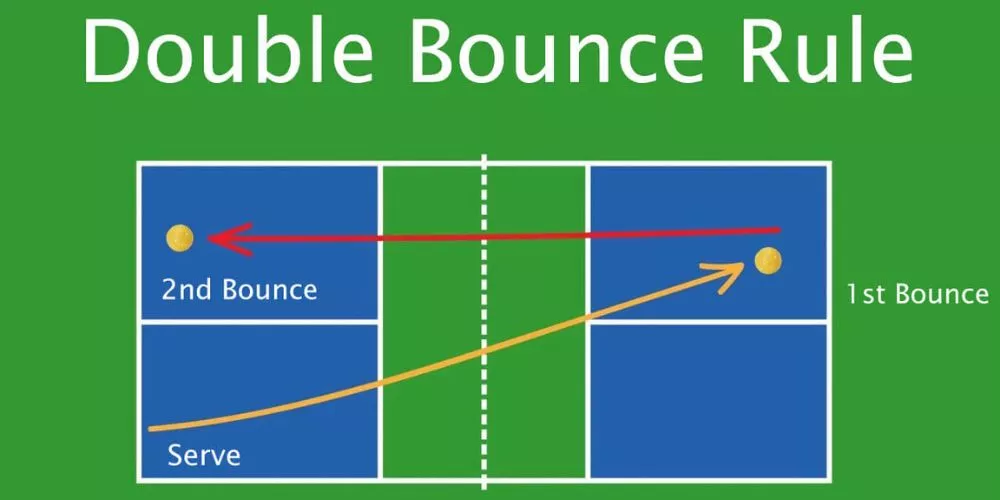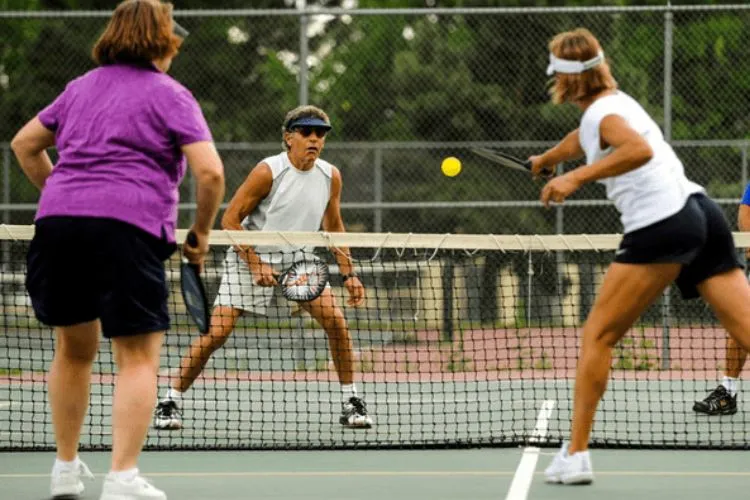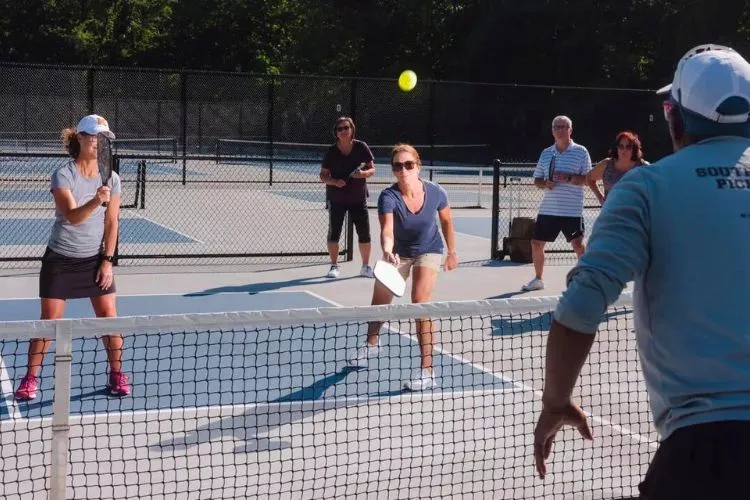Pickleball, with its fast pace and unique set of rules, can sometimes leave newcomers scratching their heads. One of the most intriguing and often misunderstood regulations is the ‘Double Bounce Rule.’ Whether you’re new to the game or a casual player, you’ve likely encountered this term and wondered what it really means.

In this article, we’ll unravel the mystery of the Double Bounce Rule, explaining its significance, how it affects your gameplay, and why it’s essential for a fair and enjoyable match. Understanding this rule is key to improving your strategy and making the most of your time on the court.
So, let’s dive in and explore one of pickleball’s most crucial rules!
What is Double Bounce Rule in Pickleball?
The Double Bounce Rule, also known as the “Two Bounce Rule,” is one of the foundational rules in pickleball – a unique mix of tennis, badminton, and ping-pong.
With pickleball gaining popularity over the years, understanding this rule becomes essential for both competitive players and casual enthusiasts.
The rule is simple yet critical. It states that each team must allow the ball to bounce once on their side of the court before hitting it for the first time on the return.
In short, the ball must bounce once on the serve, once on the return, and only after these two bounces can players on either side begin to volley the ball, i.e., hitting it before it bounces.
Here’s how it works in practice:
- The serving team hits the ball diagonally into the opposite court.
- The receiving team must let the ball bounce once before returning it.
- Then, the serving team must also let the ball bounce again on their side of the court before playing their first return.
- After these two initial bounces – one in each team’s court – the ball can be either volleyed (hit before it bounces) or ground stroked (hit after one bounce) for the remainder of the point.
The purpose of the Double Bounce Rule is to temper the serve-and-volley advantage, typically seen in games like tennis or table tennis, by forcing players to stay back till the double bounce is complete.
This rule creates a unique and nuanced approach to offense and defense in pickleball, making the game equally tactical and physical.
Who calls a double bounce in pickleball?
In pickleball, the enforcement of the ‘double bounce rule’ largely depends on the context of the game.
In an informal or recreational play, it’s usually up to the players themselves to decide and call out any faults, including a violation of the double bounce rule.
This requires all players to have a good understanding of the rule and uphold the principles of fair play.

However, in an official tournament setting, the situation differs. Many tournaments follow the rules set forth by the International Federation of Pickleball (IFP).
The IFP clearly states the double bounce rule in their official rulebook. Despite the existence of official rules, not all matches in tournaments have referees.
In unofficial matches, similar to recreational play, the players themselves are responsible for calling out faults.
In officiated matches, line judges and referees oversee the correct implementation of game rules.
They have the responsibility to call out violations of the double bounce rule if a player mistakenly volleys the ball before the two initial bounces are complete.
To conclude, proper rule adherence is a shared responsibility between the players and officials, depending on the context of the game.
Differences in Rule Implementation: Casual Play vs. Tournament Play
With the escalating popularity of pickleball, it’s essential to realize that the application and enforcement of rules, including the “Double Bounce Rule,” can vary significantly between casual and tournament play.
In casual play, sportsmanship and friendly competition are usually prioritized. Here, all players are expected to have a basic understanding of the rules and make the calls themselves.
The double bounce rule, much like all other rules, relies on opponents’ honesty and mutual trust.

Since casual games are for fun, the focus often shifts from strict rule enforcement to enjoying the game.
Some minor rule violations might be overlooked for the sake of keeping the game flowing.
However, in tournament play, the stakes are higher, and the emphasis on strict rule adherence is much more pronounced.
Most tournaments follow the rulebook issued by the International Federation of Pickleball (IFP) or USAPA.
In these scenarios, referees or line judges may be present to enforce rule implementation. They are responsible for verifying faults like the violation of the double bounce rule.
Not all tournament matches have officials, though. In non-officiated matches, the responsibility of making calls still rests with the players.
However, players here are expected to strictly follow the rules considering the competitive nature of tournament games.
Overall, the key difference lies in the level of formality and rigor in rule enforcement between casual play and tournament play.
Strategies for Using the Double Bounce Rule to Your Advantage
When it comes to using the Double Bounce Rule to your advantage in the game of pickleball, the key lies in understanding the rule’s implications and adopting strategic moves accordingly.
Here are some strategies that might help:

- Control the Depth of your Return: The second bounce (on the server’s side of the court) gives you a momentary advantage. If your return is deep, it can force the opponent back, making it challenging for them to volley immediately, and also opening the court for your next shot.
- Exploit the No-Volley Zone: Due to the double bounce rule, neither team can volley the ball until both bounces have happened. This restricts the players from rushing towards the net or the no-volley zone (kitchen) too early. Strategizing your shots to land close to the net can force your opponents back, giving you time to position yourself better for the next move.
- Fractional Delay in Return: A fractional delay in hitting your return after the first bounce can work well. It could buy you an extra second, causing the opponents to potentially mistime their shot.
- Slow-Paced Returns: Unlike tennis, power isn’t always advantageous in pickleball. A slower-paced return can be more difficult for your opponent to return before it bounces, thereby forcing them into a defensive position.
- Plan your Positioning: Aim your returns in such a way that forces your opponent to move around the court. This enables you to strategize and control the pace of the game better.
In essence, exploiting the Double Bounce Rule is about manipulating time and space on the court to your advantage.
Creating a challenge for your opponent to make their second bounce return or disrupting their usual pattern with the help of this rule can provide you with a strategic edge in the game.
Frequently Asked Questions (fAQs)
u003cstrongu003eCan you let the ball bounce twice on your side before hitting it in pickleball?u003c/strongu003e
No, you cannot let the ball bounce twice on your side before hitting it in pickleball. According to the rules of pickleball, it’s stated that the ball must be struck before it bounces twice. Not returning the ball before the second bounce would result in a point being scored for the opposing side.
Can the second bounce in pickleball be in the kitchen?
Yes, the second bounce in pickleball can indeed be in the kitchen. This area, also known as the non-volley zone, is a space where players may not volley the ball, but they are allowed to enter it to play the ball if it bounces first. So, if the ball bounces in the non-volley zone after the serve or during a rally, players can hit it.
What is the double bounce rule means that the ball must bounce on the serve and on the return before it can be volleyed?
The double bounce rule or the two-bounce rule in pickleball indicates that after the serve, the ball must bounce once on the receiving team’s side and then once on the serving team’s side before players are permitted to volley the ball, i.e., hit it before it bounces. This rule helps to disallow the serve u0026amp; volley advantage prevalent in other sports like tennis.
How many times can you bounce the ball before serving in pickleball?
There is no specific rule regarding bouncing the ball before serving in pickleball. In theory, you could bounce the ball a few times to prepare for your serve, keeping in mind the game’s flow. However, once the serve has been hit, the aforementioned double bounce rule applies.
How many times can the ball bounce in pickleball?
In general, the ball can bounce only once in pickleball. However, under the double bounce rule, during the serve and the subsequent return, the ball must bounce once each time, meaning it can bounce twice. But, if it bounces twice on one side during regular play, that would result in a point for the opponent.
Conclusion:
The double bounce rule is a fundamental component of pickleball which adds a unique dynamic to the game.
It demands the ball to bounce once on each side of the court during service and return, disallowing immediate volleys and fostering longer rallies.
Understanding and implementing this rule is crucial for both beginners and advanced players.
While it may seem a bit tricky initially, with practice, one can master it, enhancing not just their strategic playbook but also adding to the overall enjoyment of this fast-growing sport.

Pickleball’s more than a game to me—it’s a passion. I write, sharing its highs and lows, the thrills and the lessons. Some tales might draw you to the court, while others give a hint of the game’s magic. So, curious about my journey? Ready to dive deep into the world of pickleball with me? Let’s go.
